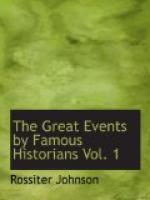[Illustration]
[Illustration: THE TRILINGUAL INSCRIPTION OF THE ROSETTA STONE. IN HIEROGLYPHIC, DEMOTIC, AND GREEK CHARACTERS. BRITISH MUSEUM, LONDON.
(FOR DESCRIPTION OF THIS CUT, SEE OTHER SIDE.)]
THE ROSETTA STONE
Almost as interesting as the Rosetta Stone itself is the story of its discovery. During the French occupation of Egypt soldiers were digging out the foundations of a fort, and in the trench the famous tablet was found. At the peace of Alexandra the Rosetta Stone passed to the English, who (1801) housed it in the British Museum, where it remains. The text when translated showed that the inscription is a “decree of the priests of Memphis, conferring divine honors on Ptolemy V, Epiphanes, King of Egypt, B.C. 195,” on the occasion of his coronation. Further it commands that the decree be inscribed in the sacred letters (hieroglyphics); the alphabet of the people (enuchorial or demotic); and Greek.
It was recognized by the trustees of the British Museum that the problem of the Rosetta Stone was one which would test the ingenuity of the scientists of the world to unfathom, and they promptly published a carefully prepared copy of the entire inscription. Scholars of every nation exhausted their learning to unravel the riddle, but beyond a few shrewd guesses (afterward proved to be quite incorrect) nothing was accomplished for a dozen years. The key was there, but its application required the inspired insight of genius.
Dr. Thomas Young, the demonstrator of the vibratory nature of light, who had perhaps the most versatile profundity of knowledge and the keenest scientific imagination of his generation, undertook the task.
Accident had called Young’s attention to the Rosetta Stone, and his rapacity for knowledge led him to speculate as to the possible aid this trilingual inscription might offer in the solution of Egyptian problems. Having an amazing faculty for the acquisition of languages, he, in one short year, had mastered Coptic, after having assured himself that it was the nearest existing approach to the ancient Egyptian language, and had even made a tentative attempt at the translation of the Egyptian scroll. This was the very beginning of our knowledge of the meaning of hieroglyphics.
The specific discoveries that Dr. Young made were: 1, That some of the pictures of the hieroglyphics stand for the names of the objects delineated; 2, that other pictures are at times only symbolic; 3, that plural numbers are represented by repetition; 4, that numerals are represented by dashes; 5, that hieroglyphics may read either from the right or from the left, but always from the direction in which the animals and human figures face; 6, that a graven oval ring surrounds proper names, making a cartouche; 7, that the cartouches of the Rosetta Stone stand for the name of Ptolemy alone; 8, that the presence of a female figure after such cartouches always denotes the female sex; 9, that within the cartouches the hieroglyphic symbols have an actual phonetic value, either alphabetic or syllabic; and 10, that several dissimilar characters may have the same phonetic value.




